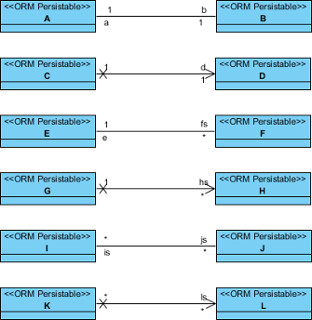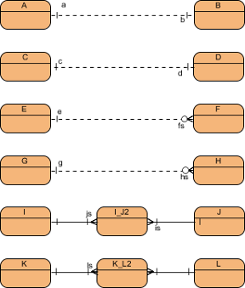Mapping Object Model to Data Model
Visual Paradigm supports Object Relational Mapping (ORM) which maps object models to entity relational models and vice versa. Visual Paradigm helps mapping between Java objects to relational database. It not only preserves the data, but also the state, foreign/primary key mapping, difference in data type and business logic. Thus, you are not required to handle those tedious tasks during software development.
Mapping classes to entities
Generally speaking, the mapping between class and entity is a one-to-one mapping, meaning that one class in object model maps with one entity in data model. Classes that map with entities are represented by the stereotype <<ORM Persistable>>.
 |
| Mapping class |
In the above example, the Customer class is the object equivalent of the Customer entity. This means that in application development or in runtime, an instance of Customer (class) stores the information of a customer retrieved from the Customer table of database.
Mapping attributes to columns
Since the persistent classes map to the entities, persistent attributes map to columns accordingly. Visual Paradigm ignores all non persistent attributes such as derived values.
 |
| Mapping attributes |
Mapping data type
Persistent attribute types are automatically mapped to appropriate column data types of the database you desired. The following table lists out the typical mapping between object model and data model. Note that the actual data type to map to depends on the default database you selected in database configuration.
|
||||||||||||||||||||||||||||||||||||||
| Mapping of data types between object and data model |
Mapping primary key
You can map an attribute to a primary key column. When you synchronize the ORM-Persistable Class to the ERD, you will be prompted by a window to select primary key.
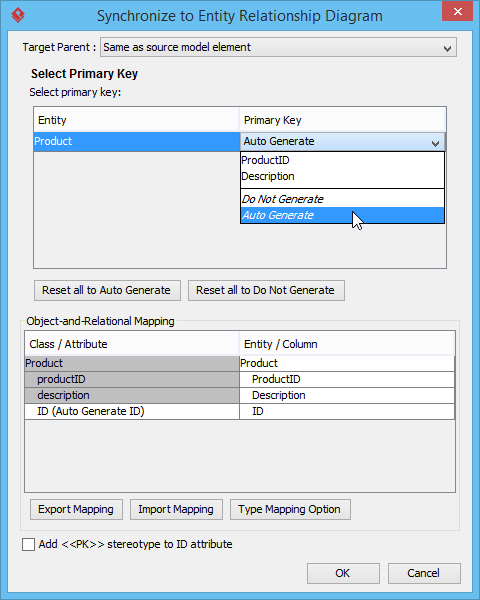 |
| Selecting the way to map primary key |
You can select an existing attribute as primary key, let us generate one for you. or select Do Not Generate to leave the generated entity without primary key.
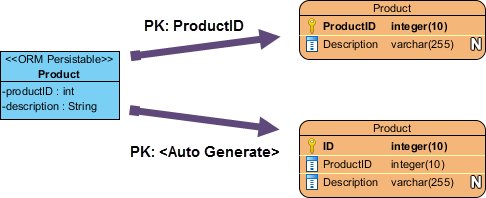 |
| Mapping primary key |
The above diagram shows if you assign ProductID as primary key, the ProductID of the generated entity, Product will become bold; whereas if you select Auto Generate for the primary key, Visual Paradigm generates an additional attribute ID as the primary key of the Product entity.
Mapping association
Association represents a binary relationship among classes. Each class of an association has a role. A role name is attached at the end of an association line. Visual Paradigm maps the role name to a phrase of relationship in the data model.
Mapping aggregation
Aggregation is a stronger form of association. It represents the "has-a" or "part-of" relationship.
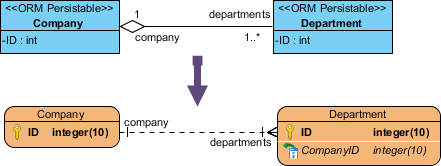 |
| Mapping aggregation |
In the above example, it shows that a company consists of one or more department while a department is a part of the company.
| NOTE: | You have to give the role names, "ConsistsOf" and "is Part Of" to the classes, Company and Department in the association respectively in order to proceed to the generation of code. |
Mapping composition
Composition implies exclusive ownership of the "part-of" classes by the "whole" class. It means that parts may be created after a composite is created, meanwhile such parts will be explicitly removed before the destruction of the composite.
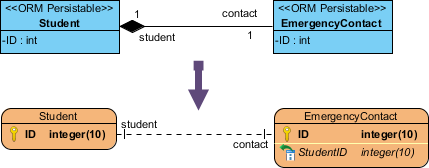 |
| Mapping composition |
In the above example, Visual Paradigm performs the Primary/Foreign Key Column Mapping automatically. ID of the Student entity is added to the entity, EmergencyContact as primary and foreign key column.
Mapping multiplicity
Multiplicity refers to the number of objects associated with a given object. There are six types of multiplicity commonly found in the association. The following table shows the syntax to express Multiplicity.
|
||||||||||||||
| Description of multiplicities |
 |
| Mapping multiplicity |
In the above example, it shows that a parent directory (role: parent) contains zero or more subdirectories (role: children).
Mapping many-to-many association
For a many-to-many association between two classes, Visual Paradigm will generate a Link Entity to form two one-to-many relationships in-between two generated entities. The primary keys of the two entities will migrate to the link entity as the primary/foreign keys.
 |
| Mapping many-to-many association |
In the above example, Visual Paradigm generates the link entity, Student_Course between entities of Student and Course when transforming the many-to-many association.
Mapping inheritance/generalization
Generalization distributes the commonalities from the superclass among a group of similar subclasses. The subclass inherits all the superclass's attributes and it may contain specific attributes.
We provide multiple strategies for transforming the generalization hierarchy to relational model. Click here to learn more about the various inhertance strategies.
Mapping collection of objects to Array Table
For a persistent class acting as persistent data storage, it may consist of a persistent data containing a collection of objects. Visual Paradigm promotes the use of Array Table to allow users retrieve objects in the form of primitive array.
When Visual Paradigm transforms a class with an attribute of array type modifier, this attribute will be converted to an Array Table automatically. The generated entity and the array table form a one-to-many relationship.
 |
| Mapping collection of objects to Array Table |
In the above example, each contact person may have more than one phone numbers. In order to ease the retrieval of a collection of phone objects, Visual Paradigm converts the phone attribute into a ContactEntry_Phone array table.
Typical mapping between object model and data model
|
||||
| Typical mapping between object model and data model |
Related Resources
The following resources may help you to learn more about the topic discussed in this page.
| 16. Using Partial Table | Table of Contents | 18. Mapping Data Model to Object Model |
